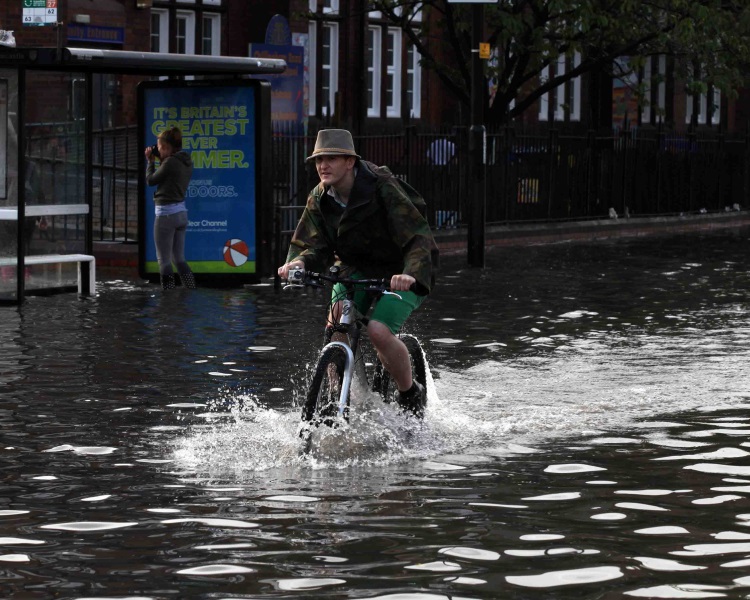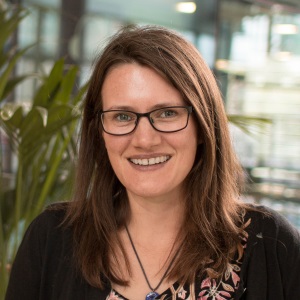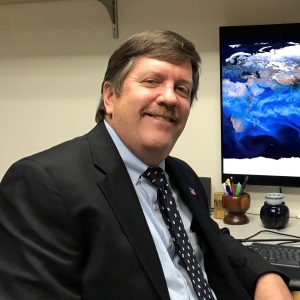Links to external sources may no longer work as intended. The content may not represent the latest thinking in this area or the Society’s current position on the topic.
Understanding intensification of short-duration rainfall extremes

Satellite meeting organised by Professor Hayley Fowler.
The satellite meeting continued the discussion meeting Intensification of short-duration rainfall extremes and implications for flash flood risks but with a clearer focus on process understanding and integrating/synthesising research results from different international groups working in this area with identification of key research gaps and research studies that can address these.
Speaker biographies and abstracts are available below. Recorded audio of the presentations is also available below.
Attending this event
This meeting has taken place.
Enquiries: contact the Scientific Programmes team
Organisers
Schedule
Chair

Dr Andreas Prein, National Center for Atmospheric Research, USA

Dr Andreas Prein, National Center for Atmospheric Research, USA
Dr Andreas Prein is a scientist at the National Center for Atmospheric Research (NCAR) in Boulder, Colorado, USA, where he is working in the Capacity Center for Climate and Weather Extremes. Dr Prein has a PhD in Physics and a Master in Environmental System Sciences from the University of Graz in Austria. He is an expert in high-resolution climate modelling and observational data analysis. He is interested in the interaction between the climate system and weather extremes. Most of his work focuses on convective extreme events such as extreme precipitation and hail.
| 09:05 - 09:30 |
Aims and objectives of the meeting

Professor Hayley Fowler, Newcastle University, UK

Professor Hayley Fowler, Newcastle University, UKProfessor Hayley Fowler is Professor of Climate Change Impacts in the School of Engineering at Newcastle University. Her research focuses on improved physical understanding of changing precipitation extremes and providing better projections for climate adaptation. She has pioneered new downscaling techniques to bridge the gap between climate modellers and users of climate scenarios (eg UKCP09 Weather Generator). She is a Fellow of the American Geophysical Union (2018) and a Royal Society Wolfson Research Fellow (2014–2019) for her work on understanding climate change impacts on hydrological systems, extreme rainfall and flooding, following a Philip Leverhulme Prize (2011) and NERC Postdoctoral Fellowship (2006–2010). She leads the GEWEX Hydroclimatology Panel sub-daily precipitation cross-cut, is Chief Editor of Frontiers in Interdisciplinary Climate Studies and is a Contributing Author to the Water Cycle and Extremes Chapters for the WGI IPCC 6th Assessment Report. |
|
|---|---|---|
| 09:30 - 09:50 | Discussion | |
| 09:50 - 10:10 |
Dependence of short-duration rainfall to temperature across Australia
Predicting future short-duration rainfall extremes is difficult. Therefore, many studies condition rainfall extremes on exogenous variables to gain insights on how extremes may change in the future. This presentation reviews literature using Australian data to study the historical day-to-day dependence of rainfall extremes on various climatic variables. Daily rainfall extremes show little homogeneity in their dependence with temperature across Australia. Contrary to expectation, many sites exhibit decreasing rainfall extremes with increasing temperatures. However, a dependence close to the theoretical Clausius-Clapeyron relationship is obtained when dew point temperature, a measure of absolute humidity, is matched to daily rainfall extremes. As rainfall intensity has a positive dependence with integrated water vapour across Australia, it is reasoned that when moisture is available, excess heat results in more evaporation as opposed to an increased air temperature, causing negative relationships between rainfall and temperature. When sub-daily rainfall extremes are examined, the dependence between rainfall and dew point temperature is consistently greater than Clausius-Clapeyron suggesting dynamic intensification of rainfall extremes with higher temperatures. Confounding factors such as embedded storms and mixing of storm durations are discussed with the suggestion that the most intense portion of a storm is the most likely to intensify with higher temperatures. 
Dr Conrad Wasko, University of Melbourne, Australia

Dr Conrad Wasko, University of Melbourne, AustraliaConrad Wasko is currently a McKenzie Fellow at the University of Melbourne. Conrad has over ten years experience in both consulting and research. He has contributed to the Australian national guidelines on flood estimation and his research into understanding the effect of higher temperatures on rainfall patterns was awarded the Lorenz G Straub award for the best PhD thesis globally in water engineering. |
|
| 10:10 - 10:30 |
Strong relationship between observed sub-daily precipitation extremes to dewpoint temperature
The intensity and frequency of extreme precipitation events have increased globally and are likely to rise further under the warming climate. The Clausius-Clapeyron (CC) relationship (scaling) provides a physical basis to understand the relationship of precipitation extremes with temperature. Recent studies have used global sub-daily precipitation data from satellite, reanalysis and climate model outputs (due to the limited availability of long term observed sub-daily data at global scales) and have reported a higher sensitivity of sub-daily precipitation extremes to surface air temperature than for daily extremes. Moreover, at higher temperatures, moisture availability becomes the dominant driver of extreme precipitation, therefore, dewpoint temperature can be a better scaling variable to overcome humidity limitations as compared to air temperature. Here, the group used hourly precipitation data from the Global Sub-daily Rainfall (GSDR) dataset and daily dewpoint temperature data (DPT) from the Met Office Hadley Centre observations dataset (HadISD) at 6695 locations across the United States of America, Australia, Europe, Japan, India and Malaysia. The team found that more than 60% of locations (scaling estimated for individual location) show scaling greater than 7%/K (CC rate). Moreover, more than 55% of locations across Europe, Japan, Australia and Malaysia show scaling greater than 1.5CC. Furthermore, when locations across selected regions are pooled within similar climatic zones (based on Koppen Geiger classification), scaling curves show around 7%/K scaling. The scaling curves for locations at greater altitude (>400m MSL) are flat compared to locations at relatively lower altitude. The difference in scaling rates at-station and for pooled regions highlight the importance of understanding the thermodynamic and dynamic processes governing precipitation extremes at different spatial scales and indicate that local processes are driving the super-CC sensitivities in most regions. 
Dr Haider Ali, Newcastle University, UK

Dr Haider Ali, Newcastle University, UKDr Haider Ali is currently a research associate at Newcastle University working in INTENSE project with Professor Hayley Fowler. Haider finished his PhD in Civil Engineering from the Indian Institute of Technology Gandhinagar, India. His work includes studying the relationship of sub-daily and daily rainfall extremes to temperature (scaling) and design of nonstationary intensity-duration-frequency curves for stormwater infrastructure designs. |
|
| 10:30 - 11:00 | Coffee | |
| 11:00 - 12:30 | Discussion |
Chair

Dr Michael Wehner, Lawrence Berkeley National Laboratory, USA

Dr Michael Wehner, Lawrence Berkeley National Laboratory, USA
Dr Michael F Wehner is a senior staff scientist in the Computational Research Division at the Lawrence Berkeley National Laboratory. Dr Wehner’s current research concerns the behaviour of extreme weather events in a changing climate, especially heat waves, intense precipitation, drought and tropical cyclones. Before joining the Berkeley Lab in 2002, Wehner was an analyst at the Lawrence Livermore National Laboratory in the Program for Climate Modeling Diagnosis and Intercomparison. He is the author or co-author of over 170 scientific papers and reports. He was a lead author for both the 2013 Fifth Assessment Report of the Intergovernmental Panel on Climate Change and the 2nd, 3rd and 4th US National Assessments on climate change. He is currently a lead author for the upcoming Sixth Assessment Report of the Intergovernmental Panel on Climate Change. Dr Wehner earned his masters degree and PhD in nuclear engineering from the University of Wisconsin-Madison, and his bachelors degree in Physics from the University of Delaware.
| 13:30 - 13:50 |
Non‐stationarity and flooding
Flooding is one of the costliest natural hazards and it is often associated with a high toll in terms of fatalities. Over the past several decades, the frequency and magnitude of these events have been changing, complicating the capability to prepare to and respond against this hazard. Most of the literature has focused on the detection of changes in flooding, with much less emphasis on their attribution. Improving our understanding of the physical drivers that are responsible for the observed changes in this natural hazard can enhance our capability of predicting and projecting these changes, with large implications for water resources management and the design of hydraulic structures. This presentation will discuss some of the issues associated with the nonstationarity in the flood records, and provide an overview of some of the methodologies to deal with these changes. 
Dr Gabriele Villarini, University of Iowa, USA

Dr Gabriele Villarini, University of Iowa, USAGabriele Villarini is an associate professor in the Department of Civil and Environmental Engineering at the University of Iowa, and the Director of IIHR-Hydroscience & Engineering. He received his PhD in Civil and Environmental Engineering in 2008 from the University of Iowa; he also received his Executive MBA from the Tippie School of Business at the University of Iowa in 2018. His research interests focus on flood hydrology, extreme events, hydroclimatology, and climate predictions and projections. He has received a number of national and international awards, including the “Hydrological Sciences Outstanding Young Scientist Award” by the European Geosciences Union (2013) and the James B. Macelwane Medal by the American Geophysical Union (2016). He is a Fellow of the American Geophysical Union (2016). He has published over 170 peer-reviewed papers, including articles in Nature, Science, Nature Climate Change and the Proceedings of the National Academy of Sciences. |
|
|---|---|---|
| 13:50 - 14:10 |
A synthesis of hourly and daily precipitation extremes in different climatic regions
Climatological features of observed annual maximum hourly precipitation have not been documented systematically compared to those on daily timescales due to observational limitations. Drawing from a quality-controlled database of hourly records sampling different climatic regions including the United States, Australia, the British Isles, Japan, India and peninsular Malaysia available over multiple decades, we examined climatological features of annual maximum precipitation (AMP) across timescales ranging from 1-hr to 24-hr. Climatological features include seasonal and diurnal distribution of AMP, the storm duration triggering AMP, as well as the relation with the convective available potential energy. This study provides insights on climatological features of hourly precipitation extremes and how they contrast with the daily extremes examined in most studies. 
Dr Renaud Barbero, National Research Institute of Science and Technology for Environment and Agriculture, France

Dr Renaud Barbero, National Research Institute of Science and Technology for Environment and Agriculture, FranceRenaud Barbero is currently a research scientist at the National Research Institute of Science and Technology for Environment and Agriculture in France. Renaud is interested in climate extremes, drought, precipitation, the mechanisms underlying climate-wildfire linkages, statistical modelling, and climate change. Renaud graduated at the University of Aix-Marseille in France and did a post-doc at the University of Idaho, US and at Newcastle University, UK where he examined subdaily precipitation extremes in the framework of the Intense project. |
|
| 14:10 - 15:00 | Discussion | |
| 15:00 - 15:30 | Tea | |
| 15:30 - 15:50 |
The role of short-duration high-intensity precipitation in geohazards and information needs in a changing climate
There is a well-established connection between short-duration, high-intensity rainfall and geohazards such as shallow landslides and post-wildfire debris flows. The applied meteorology and geomorphology research communities in the western United States are currently working together to improve early warning and forecasting of potential impacts of these geohazards. One of the questions these scientists often hear from floodplain managers and community planners is, “How will the frequency and impacts of geohazards change in a warming climate?” To address this question, sub-daily precipitation projections at spatial scales relevant to the geohazards in question are necessary. For application in the far western United States, there must be consideration of short-duration precipitation changes within cool season mid-latitude cyclones, as they produce the highest precipitation intensities in these regions. This poster demonstrates the common meteorological drivers of short-duration, high-intensity precipitation producing cool-season shallow landslides and post-wildfire debris flow events in the western United States. Additionally, it describes the temporal and spatial resolutions needed in precipitation projections such that they can be applied to these geohazards. Current research goals on climate change, precipitation intensification, and geohazards are also discussed to stimulate a conversation about data needs from the applied research communities to promote collaboration and progress. 
Dr Nina S Oakley, Western Regional Climate Center, Desert Research Institute, USA

Dr Nina S Oakley, Western Regional Climate Center, Desert Research Institute, USANina Oakley is a research professor in the Division of Atmospheric Sciences at the Desert Research Institute in Reno, Nevada, USA. She also serves as Regional Climatologist for the Western Regional Climate Center and is a research affiliate with the Center for Western Weather and Water Extremes (CW3E) at Scripps Institution of Oceanography. Her work focuses on understanding the drivers and impacts of extreme precipitation in mid-latitude cyclones in the mountainous regions of the western United States. One particular interest is the characteristics and predictability of storm events that can initiate post-wildfire debris flows. Nina is also working on ways to make information on precipitation extremes, especially in a changing climate, more accessible to communities outside atmospheric science such as geomorphologists, floodplain managers, emergency managers, community planners, and decision-makers. |
|
| 15:50 - 16:10 |
What can the UK rain gauge network tell us about changes to intense rainfall?
It is widely expected that anthropogenic warming will lead to an increase in the intensity of extreme rainfall. The Clausius-Clapeyron (CC) relationship indicates an increase of ~7% per degree of warming, but in some regions the scaling rate for hourly extremes has been observed to be higher, leading to concerns over increased risk of flash flooding in the future. The group has collected and quality-controlled data from ~2000 rain gauges across the UK, providing high resolution rainfall data to assess the climatology of extremes at timescales from 5 minutes through to 5 days, leading to improved understanding of when and where intense rainfall is more likely. They have also quantified changes in hourly extremes and find evidence of recent intensification in summer. However, although intense UK summer rainfall was found to scale in accordance with the CC relationship suggesting a possible thermodynamic cause, the group cannot rule out the influence of large-scale modes of variability as potential mechanisms, especially as they note the dependence of intense rainfall on weather patterns. These results highlight the difficulties of both quantifying, and understanding the processes behind, observed changes in intense rainfall, and confirm the need to combine knowledge derived from observational and modelling studies. 
Dr Stephen Blenkinsop, Newcastle University, UK

Dr Stephen Blenkinsop, Newcastle University, UKDr Stephen Blenkinsop is a Senior Research Associate in climate and climate change at Newcastle University having completed his PhD at the Climatic Research Unit, University of East Anglia, in 2005. His research focuses on extreme events, their historical variability and change, future projections and impacts, and drivers. He has worked on a series of projects developing and using downscaling methods to derive improved projections of a wide range of climate change impacts for regions across the globe. His most recent work has focused on the development of quality-controlled, sub-daily rainfall datasets for the UK which has contributed methods to the INTENSE project. He has recently used these datasets to undertake the first analysis of change and variability in UK hourly rainfall extremes which is leading to new studies of the drivers of variability in intense rainfall. Stephen also lectures on modules on Newcastle University’s undergraduate and Masters engineering programmes, and is a co-author on >50 publications. |
|
| 16:10 - 17:00 | Discussion |
Chair

Professor Hayley Fowler, Newcastle University, UK

Professor Hayley Fowler, Newcastle University, UK
Professor Hayley Fowler is Professor of Climate Change Impacts in the School of Engineering at Newcastle University. Her research focuses on improved physical understanding of changing precipitation extremes and providing better projections for climate adaptation. She has pioneered new downscaling techniques to bridge the gap between climate modellers and users of climate scenarios (eg UKCP09 Weather Generator). She is a Fellow of the American Geophysical Union (2018) and a Royal Society Wolfson Research Fellow (2014–2019) for her work on understanding climate change impacts on hydrological systems, extreme rainfall and flooding, following a Philip Leverhulme Prize (2011) and NERC Postdoctoral Fellowship (2006–2010). She leads the GEWEX Hydroclimatology Panel sub-daily precipitation cross-cut, is Chief Editor of Frontiers in Interdisciplinary Climate Studies and is a Contributing Author to the Water Cycle and Extremes Chapters for the WGI IPCC 6th Assessment Report.
| 09:00 - 09:30 |
Review of previous day

Professor Hayley Fowler, Newcastle University, UK

Professor Hayley Fowler, Newcastle University, UKProfessor Hayley Fowler is Professor of Climate Change Impacts in the School of Engineering at Newcastle University. Her research focuses on improved physical understanding of changing precipitation extremes and providing better projections for climate adaptation. She has pioneered new downscaling techniques to bridge the gap between climate modellers and users of climate scenarios (eg UKCP09 Weather Generator). She is a Fellow of the American Geophysical Union (2018) and a Royal Society Wolfson Research Fellow (2014–2019) for her work on understanding climate change impacts on hydrological systems, extreme rainfall and flooding, following a Philip Leverhulme Prize (2011) and NERC Postdoctoral Fellowship (2006–2010). She leads the GEWEX Hydroclimatology Panel sub-daily precipitation cross-cut, is Chief Editor of Frontiers in Interdisciplinary Climate Studies and is a Contributing Author to the Water Cycle and Extremes Chapters for the WGI IPCC 6th Assessment Report. |
|
|---|---|---|
| 09:30 - 10:00 | Discussion | |
| 10:00 - 10:30 |
Accounting for large-scale circulation effects on extreme precipitation

Professor Richard Allan

Professor Richard AllanI am professor of Climate Science at the University of Reading Department of Meteorology. My research is driven by the fundamental question: how much will Earth warm in the current century and what are the implications for the global water cycle, upon which societies and ecosystems depend? I use Earth Observation data to explore fluctuations in clouds, water vapour, rainfall and the Earth's radiative energy balance and use this information to assess the realism of climate prediction models and improve our understanding of the climate system. I am a lead author on the Water Cycle Changes chapter of the IPCC AR6 Working Group 1 report. |
|
| 10:20 - 10:40 |
UKCP: Understanding uncertainty in future changes in precipitation extremes at convection-permitting scale
Convection-permitting models (CPMs) provide a better representation of sub-daily precipitation statistics and convective processes, both on climate and NWP time scales, mainly thanks to the possibility to switch off the parameterisation of convection. The improved realism of these models gives us greater confidence in their ability to project future changes in short-duration precipitation extremes. The first 12-member ensemble of convection-permitting climate simulations over the UK was completed within the latest updates to the UK Climate Projections (UKCP). The 20-year long CPM simulations for present-day and end of century periods are nested in an ensemble of regional climate model (RCM) simulations over Europe driven by a global climate model ensemble. In the driving ensembles, uncertain parameters in the model physics are varied within plausible bounds to sample uncertainty. Although no perturbations are applied directly to the CPMs, this project allow to provide a first-ever estimate of uncertainty at convection-permitting scale and thus provide UK risk assessment studies with more reliable climate change projections at local and hourly scales. The presentation will show results looking at the uncertainty in future changes in hourly precipitation extremes across the CPM ensemble, and how this differs from the driving RCM ensemble. 
Dr Giorgia Fosser, Met Office Hadley Centre, UK

Dr Giorgia Fosser, Met Office Hadley Centre, UKDr Giorgia Fosser graduated in civil engineering at University of Padua (Italy) with a masters in hydrology, followed by another masters in water resources management from UNESCO-IHE (The Netherlands). After, Dr Giorgia Fosser completed a PhD at Karlsruhe Institute of Technology KIT (Germany), investigating the added value of convection-permitting models (CPMs) versus coarser regional climate models (RCM) in the representation of convective precipitation in present day and under climate change scenario. She worked at Météo France (France) before joining the Met Office four years ago. She is an experienced researcher on climate analysis and convective-scale climate modelling. At the Met Office she is currently working within the UKCP18 project, investigating the impact of different convection permitting resolutions in the representation of heavy precipitation over the UK. In UKCP18, she has been responsible for running the first ensemble of convection permitting climate projections and current work focusses on understanding uncertainties in the climate change signal at convection-permitting scale. |
|
| 10:40 - 11:10 | Coffee | |
| 11:10 - 12:30 | Discussion |
Chair

Dr Conrad Wasko, University of Melbourne, Australia

Dr Conrad Wasko, University of Melbourne, Australia
Conrad Wasko is currently a McKenzie Fellow at the University of Melbourne. Conrad has over ten years experience in both consulting and research. He has contributed to the Australian national guidelines on flood estimation and his research into understanding the effect of higher temperatures on rainfall patterns was awarded the Lorenz G Straub award for the best PhD thesis globally in water engineering.
| 13:30 - 13:50 |
Implications of small‐scale processes on convection
Several studies have shown that convective extremes become more intense at increasing temperatures. They even show scaling beyond the rate indicated by the increase in atmospheric moisture given by the Clausius-Clapeyron (CC) relation. However, the process which drives this intensification is not yet well established, but is likely a combination of both thermodynamical and dynamical components. In earlier work, idealized temperature perturbed large eddy simulator (LES) experiments suggest a strong component through interaction between convective events when studied in the form of raincell tracks. Convective tracks occurring in isolation, i.e. those that develop and decay as a single track, cannot reach super-CC scaling. However, those tracks that form by the merging of two or more previous track do show super-CC behavior. To further explore this effect in less idealized settings, precipitation tracking is performed in both observations, in the form of radar measurements, and in convective permitting simulations at 3 km grid resolution over southern Sweden for historical and future climate projections. Raincell tracking is performed to gain insights into the formation and decay of tracks, as well as to determine general statistical character of the tracks, such as duration, size, intensity, etc. 
Dr Peter Berg, Swedish Meteorological and Hydrological Institute, Sweden

Dr Peter Berg, Swedish Meteorological and Hydrological Institute, SwedenPeter Berg is research leader for the field Hydrometeorological extremes in a future climate in the Hydrology research unit of the Swedish Meteorological and Hydrological Institute (SMHI). After receiving his PhD degree on stratospheric dynamics and solar-terrestrial physics at the University of Copenhagen, he changed topic toward regional climate modeling and the study of precipitation extremes. This work has continued through previous positions at the Danish Meteorological Institute, Karlsruhe Institute of Technology in Germany, and the Rossby centre at SMHI. The work has circled around the interface between meteorology and hydrology, but also moving into areas such as fire risk and operational forecasting of urban flooding. |
|
|---|---|---|
| 13:50 - 14:10 |
Climate change’s influence on June 2009 extreme precipitation event over Southeast Austria
During 22–24 June 2009, Austria witnessed a rampant rainfall spell that spread across populated areas of the country. High intensity rainfall caused 3000+ landslides in Feldbach, and property damages worth €10,000,000 in Styria itself. In a warmer climate change scenario, such an extreme precipitation event may become more intense due to higher water holding capacity of air with increased temperatures, but this reasoning may not be so straightforward considering the complex physics of precipitation. CCLM regional model is used recreate the event over the same location as the original event. Further we use CMIP5 global climate models (at the RCP8.5) scenario. In particular, these will be applied in the ‘surrogate climate change’ method. Here, the climate change signals are calculated by computing the difference between the thermodynamic fields of the CMIP5 simulations for the future and the past. A similar approach is to be applied for the ‘past’ case simulations. The idea behind this experimental setup is to establish a ‘storyline’ for the event as it would have occurred in the past, present and the future.

Aditya Narayan Mishra, University of Graz, Austria

Aditya Narayan Mishra, University of Graz, AustriaAditya N Mishra is a PhD student under the supervision of Douglas Maraun, at the Wegener Centre of the University of Graz in Austria. He is a postgraduate in Atmospheric Sciences from the well-known Indian Institute of Tropical Meteorology- IITM Pune and University of Pune. Currently he is working with convection-permitting high-resolution regional models to simulate extreme precipitation events over Central Europe. |
|
| 14:10 - 15:00 | Discussion and planning future research | |
| 15:00 - 15:30 | Tea | |
| 15:30 - 16:15 | Concluding remarks |
